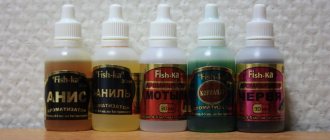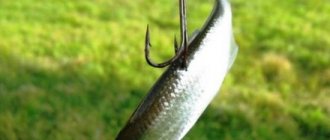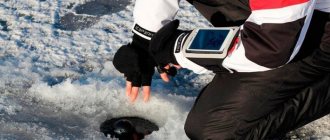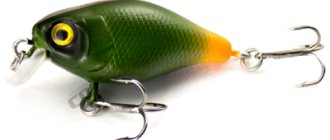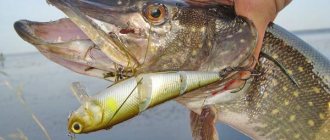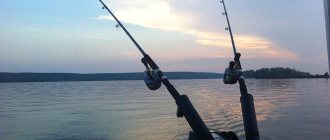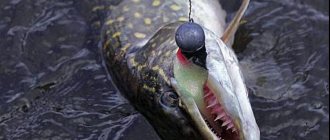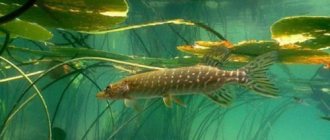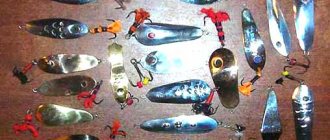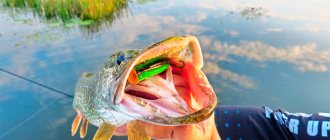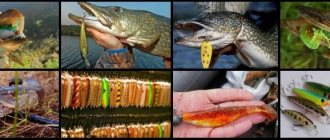Rating of wobblers for pike
This article contains the experience of three fishermen who almost came to blows while placing their favorite killer wobblers in their places.
The idea to write an article and list a rating of wobblers for pike was born completely spontaneously. The budget for this study was 5 liters of beer and more than paid for itself in the result. Each brought two of the most lethal wobblers, seasoned with stories of their exploits when catching a predator.
Please love and favor the list of the most catchy baits according to the magazine “On the Hook”:
6 Jackall squad minnow 80 sp
Saved me in situations when nothing else worked. According to the general opinion, it took an honorable sixth place among killer wobblers only because we based the rating on pike, and as it turned out, large specimens were not taken very often for this handsome one. There are a lot of small and medium fish, there are even more perches and, most importantly, it is good to use in the windows of water thickets.
Judging by the story of the owner of this wobbler, when he first tried it, he decided that there would be no business with it. The game turned out to be strange and inconsistent. But after several casts the first pike was caught. Behind her is another and another. It was hard to believe, but the pike loves it! Thus, it deservedly takes 5th place in the ranking of pike killer wobblers.
But the problem is with the coloring. It seems that the manufacturers of Megabass Vision 95 specifically made it so that after the first fishing there would be no living space left on it. Like “look how the pike beat him up”
4 Yo-Zuri L-Minnow-66
Probably the smallest of all the wobblers presented in our rating. There were a lot of controversies surrounding him, primarily because of what he was facing. Takes chub, perch and pike. Moreover, pike is small, medium in size and less common than perch, but we make the rating based on pike.
What you can’t take away from the Yo-Zuri L-Minnow-66 is its catchability. This is more of a mega universal bait for anything that is predatory and smaller than average. It is thanks to this fact that this wobbler is in fourth place. And a few words about wiring. First you need to let the wobbler sink, and then start the game.
Great option. We are talking specifically about color 050 (others are questionable). The owner of this wobbler has his own special love for this model. It was thanks to the Tsuribito Hard Minnow 95 F that he managed to take second place at regional competitions with a result of 8 kg 400 g (4 tails). This is despite the fact that none of the participants that day had more than two tails.
It was also noticed that perch never caught this wobbler at all. When replacing hooks, you can drive to a depth of 1.5 meters versus the stated 1-1.2 meters.
This competitor received third place because the second of the three fishermen had exactly the same wobbler. And he showed excellent results until he died a brave death in an unequal battle with an underwater snag.
Not every fisherman can afford such a wobbler, and thank God. This is not just a pike killer, but a ruthless destroyer weighing 13 grams. The owner boasted that when he catches with this wobbler, it feels like he is not catching, but catching. The best wiring option for him is a jerky retrieve with pauses of 5 seconds.
It was also funny to listen to the story of how, when caught, the fisherman did not pull the cord towards himself, but undressed and began to help out the breadwinner. Of course - it's Imakatsu! Deserved second place in our ranking.
He is the recognized winner! The leader among wobblers that kill pike, as well as perch and in general everything that moves. We debated for a long time between the first and second wobblers, and in terms of versatility and price range, the Zip Baits Khamsin-SR 70, in our opinion, is a little ahead. The color in the picture is 600.
Among the advantages are the magnetic system and versatility. The cast is generally 5+. It is good to use in reservoirs with stagnant water, but in rivers with flow it becomes too deep. For all its catchability, there is a minus - the quality of the varnish coating. Quite soon, in the places where the pike bites, the varnish begins to crumble and the wobbler loses its presentation. True, this does not particularly affect the result.
Lures wobblers for pike in autumn
As you know, wobblers for pike in autumn, summer and spring differ from each other. The fact is that pike is located at different depths at each time of the year, and this must be taken into account when fishing for it. In summer, pike swim at a depth of about 2 meters, and in the fall they drop to 6. Accordingly, autumn fishing for pike should take place with baits that can go to this depth and interest the predator.
General characteristics of the wobbler
A wobbler is a type of bait that resembles small fish in appearance, differing from each other in shades, shape, size, manufacturer and other characteristics. The optimal size for a wobbler for pike is from 5 to 13 cm. Its color largely depends on what time of day the fishing will be done, the transparency of the reservoir, and the current. When purchasing baits, well-known companies supply the product with information about what depth the wobblers are intended for and what body of water they are suitable for. You need to carefully read the instructions, study the relevant literature or Internet resources and strictly follow the recommendations when catching a predator. The most informative sites are highly specialized portals. As a rule, they give preference to Yo Zuri, Rapala and Megabass.
Autumn wobblers for pike
The autumn months are different in temperature, vegetation and other characteristics, and therefore catchable wobblers for pike in September and November will be different. In September, when there is a lot of vegetation and it is not possible to carry the bait across the entire water area, it is best to purchase minou-type twitching wobblers. They are medium in size (about 10 cm), and will not go too deep under water. It is best to carry out wiring in windows - places free from thickets, where the wobbler will definitely not get caught on anything. In addition, twitching models will also be successful in shallow water, in small bays, where in the summer there is a green carpet of algae.
Later, the inventory can be replenished with a crank, it is also called shad, fet (a type of bait). With it you can catch pike at greater depths, but not near the very bottom of the reservoir. You should buy a crank of at least 8 and no more than 10-11 cm. However, fishing can go well without a crank. What bait to use is up to the fisherman himself. If the deep wiring is unsuccessful, the cranks can get caught and get lost.
Fishing on the surface
When the temperature is still high enough, the predator prefers to stay close to the surface. In this sense, it is best to twitch using a variety of wobblers. For this technique you will need a short rod about 2.4 m long. The most catchy wobblers for this method are poppers, walkers, jerkbaits and gliders.
Poppers have a distinctive flat head and create splashes in the water, thereby attracting predators. Pike are actively attracted to this trick, but in the fall it can only be done before the first cold snap.
Walkers or walkers are very similar in their behavior when wiring, but have more prowling habits. However, not every novice amateur fisherman succeeds in achieving their attractive behavior on the water. It will take some technique and dexterity to move in jerky motions. If the bait is slow, the wolf will be too passive and will not interest the fish.
Jerkbaits are large wobblers that can attract pike by their size alone. They themselves create decent waves and noise.
Propbaits are another type of surface bait that are equipped with a propeller. Therefore, even maintaining them evenly allows you to achieve good results. They work great in big waves and wind.
For fishing at night on the surface or in shallow depths, the best wobblers for pike are poppers and crawlers. They are capable of creating large waves and an alluring sound that attracts predators.
Gliders are a model suitable for fishing in thickets. Thanks to the special location of the hook (it is raised up and held vertically), they are able to pass even areas with a lot of vegetation. The color of the wobbler can play a big role in this case, since it can attract fish with its color against the background of grass. You can choose bright models (for example, Croatian egg).
Pike fishing at depth
Pike is caught with special sinking models that can submerge in water without the use of weights. In their movement, these models are able to either sink to depth or rise. This behavior of the bait attracts predators. Very often, the pike rushes to such a wobbler almost immediately after casting; for this, contact with the wobbler must be maintained at each stage, keeping the line taut. In this case, posting can be done both slowly and quickly, but the best results are achieved by a stepwise movement of the bait. Types of sinking wobblers: cranks, rattlins, minou, jerkbaits, etc. They differ in the depth of their immersion and in their behavior at depth. You need to choose a wobbler based on temperature and weather conditions; your own guiding skills play an important role.
Yo Zuri L Minnow 66 is a good wobbler for fishing in early and mid-autumn. It works well at a depth of about 1.5 m. Its length is only 6 cm, but most often this bait brings fishermen a good catch. In many charts this bait is listed in the top three.
DuelDino Crank SD - these wobblers are for catching pike in the fall at a depth of up to 2.5 meters, sometimes used at a depth of 1.5 m. Well suited for inexperienced fishermen with unrefined fishing techniques. The bait needs a slow, sedate movement with short pauses.
Rapala X-Rap10 is a universal bait. It has amazingly alluring behavior on the water. Suitable for fishing on the surface and at shallow depths. Used primarily over long distances.
Tiny Magallon is a small wobbler that works great in water. In its manner of movement it is very reminiscent of a wounded fish, instantly turning on the instincts of a pike. Requires a well-practiced manner of wiring, which is carried out only with the tip of the rod and small jerks.
Megabass Giant DogX is one of the large wobblers that can move extremely quickly and sharply. Works at short and long distances. It is used mainly in early and mid-autumn when the weather is warm.
Wobbler colors
Catching pike with a wobbler in the fall at great depths does not depend on the color of the bait. Often the pike comes, I focus more on the habits of the bait. However, there are still some recommendations regarding the choice of bait depending on the weather.
On a cloudy and cloudy day, fish are best attracted to baits with golden hues that play well in the water. In clear water or at a depth of up to 1.5 meters, it is better to choose a wobbler with a silver tint; blue and dark blue colors are also suitable. When it comes to deep water or muddy water, it is better to choose orange or yellow baits.
Wiring Features
Posting in the fall depends on what body of water you are fishing in and what bait you use. There are mainly 2 types: jerking (twitching) and uniform. However, each wobbler will require some additional handling features: speed, short jerks, length of pauses, etc. Ideally, it is better to adapt to each wobbler individually. When retrieving, the most important thing is that the bait constantly plays and behaves as if it were alive. At the same time, hooks and failures should be avoided, otherwise the behavior of the bait may worsen and cease to be interesting to the predator.
The diving depth of the bait can be controlled using speed. If you reel in slowly, the wobbler will float up; if you reel in too quickly, it will begin to sink. Each bait model has its own optimal depth at which it will manifest its characteristics most clearly.
Catching pike with wobblers in summer
In the summer season, catching pike is quite difficult, since it swims far from the coast into the depths. You can catch pike during this period using all types of wobblers that are suitable for any fishing conditions.
If you will be casting bait near the banks where grass grows, then surface, slow-swimming suspended wobblers are best suited for this purpose. Usually in such areas you can catch small specimens of pike.
Larger pike are found at longer distances in water bodies. To fish in such areas, you should use sinking or floating wobblers with medium or deep water depth.
Jackall Tiny Magallon
Features of the wobbler:
- this bait is a suspended wobbler with two compositions and a length of eighty millimeters;
- it weighs seven grams;
- depth of lowering into water is up to 0.9 meters;
- thanks to the excellent play of its tail, such a wobbler perfectly lures pike, which instantly reacts to it;
- this suspender is designed for fishing in small areas of reservoirs that are overgrown with grass;
- Wiring for it should be done using the twitching method.
Orbit 65
Features of the wobbler:
- this bait is a suspender;
- can be used at a depth of up to 0.7 meters;
- its weight is five grams;
- Such a wobbler should be used in shallow ponds or rivers that are overgrown with dense algae;
- this bait has a built-in system of acoustic waves, which additionally attracts fish and makes them bite;
- Wiring with this wobbler should be done very quickly, with sharp twitching movements and sudden pauses.
Morethan X-Cross
Features of the wobbler:
- this wobbler can go deep into the water only twenty centimeters;
- it should be used exclusively in shallow areas of ponds or lakes that are completely covered with a layer of river grass;
- thanks to the excellent balance of this bait, it can be cast over long distances, which makes it very convenient, despite the shallow diving depth;
- Retrieving must be done slowly, with short pauses, during which the wobbler immediately rises to the surface.
ZipBaits Khamsin Jr
Features of the wobbler:
- this wobbler belongs to the shad class;
- is very effective for catching pike;
- in its shape it is very similar to a small crucian carp;
- the depth of immersion in water in such a wobbler is two and a half meters;
- wiring should be done very quickly with short stops.
ZipBaits Rigge 90
Features of the wobbler:
- is one of the leading lures for catching pike due to its effectiveness;
- the weight of this wobbler is ten grams;
- immersion depth - from one to one and a half meters;
- The wiring should be done smoothly, only speeding up the pace from time to time.
Smith Jib
Features of the wobbler:
- length - one hundred and ten millimeters;
- weight – eleven grams;
- classification – floating suspender;
- immersion depth – up to 0.6 meters;
- wiring – slow twitching.
Lucky Craft Pointer
Features of the wobbler:
- suspender;
- has an immersion depth of up to two meters;
- has five different types, which vary in their weight and shape;
- has a strong game, which is expressed in oscillations in different directions;
- wiring should be done evenly with short pauses.
Read: Methods of tying a jig with a ring
Rapala X-Rap
Features of the wobbler:
- immersion depth up to two and a half meters;
- produced in four different types;
- has a built-in tee and front sight on the tail;
- suspender;
- the game has sharp changes in directions of movements;
- has vibration and noticeable shine when wiring;
- Wiring can be done in any way, from twitching to uniform wiring.
Jackall Squad Minnow
Features of the wobbler:
- suspender;
- immersion depth ranges from 0.8 to 1.3 meters;
- has noise functions that attract many pikes;
- does not have a very good casting range, but this is offset by the excellent performance of the bait and its sound effects;
- wiring – uniform with short stops.
Major Craft Zoner Minnow
Features of the wobbler:
- suspender;
- the immersion depth, depending on the specific model, can be from a meter to one and a half meters;
- has its own unique game, which makes such a wobbler very popular;
- wiring - any, from fast twitching to uniform with stops.
A brief overview of the most popular wobblers for pike
The most popular wobblers for catching pike are as follows:
- Yo Zuri L Minno is the most commonly used model. It is 6 cm long. The working depth of the bait is 1.6 m.
- Owner - can be used in various. It is a model for use in twitching.
- Duel Dino Crank SD - great for catching pike at great depths (2-3 m).
- Rapala X-Rap 10 is the best for long casting.
- Tiny Magallon - has the advantage of its lively play in the water and noticeable color scheme.
Tips and tricks:
- You should always use a leash together with a wobbler. It can be made from guitar string.
- The fisherman must constantly monitor how the bait behaves in the reservoir, and knowing this, use its features when catching fish.
- If the bait has never fulfilled its function over several fishing processes, then it needs to be replaced.
- Pike looks at the bait along the lateral line, so the purely mechanical features of the bait are more important to it, and not how much it resembles a live fish and what color it has.
Tackle and their categories
Of all the baits that are famous for their good catchability, the most popular are wobblers for pike, which imitate the agony of a wounded fry. Usually, pike looks for holes and gullies for hunting, located near places where there is shallow water with a weak current. It is in such places that an experienced fisherman chooses to try casting a wobbler-minnow for pike.
Looking for wobblers-minnows for pike for fishing, the catalog of which will probably be found among your fishing friends, even a beginner has a real chance to return home with a trophy. It is these tackles that are considered the best wobblers for twitching pike. If you ask 10 experienced fishermen what kind of bait they want to work with, 8 people will choose a minnow class wobbler.
Factors that are taken into account when purchasing are buoyancy and diving depth.
Buoyancy and immersion categories:
- sinking - transitional models are strongly plunging and slowly sinking;
- swimming or imitating the movement of fry;
- strongly floating;
- suspenders - this type of bait imitates a suspended state, so when choosing a pike type of suspender, you need to have a good understanding of the currents of the reservoir, know deep and shallow places.
Surface wobblers not included in the list, but with great potential
JACKALL Boil Trigger
Boil Trigger
is more than a popper. This is a separate class of baits for which a name has not yet been invented.
A special feature of the wobbler is its position on the surface of the water. It lies on its side in a slightly curved position, and with slight periodic twitches the Boil Trigger can be given a game that very accurately imitates a dying fry that lies on the surface of the water and periodically shudders in agony. This animation is called dead sticking and is very effective against passive pike and fattening perch in “cauldrons”.
In addition, the new bait can be successfully used as a walker; when conducting a “dog walk”, in addition to the standard movement to the sides, it rolls from side to side, which turns on even the most passive perch. But that’s not all - by increasing the jerk strength and decreasing the frequency, you can turn the Boil Trigger into a popper, and if you jerk sharply enough, you can even perform twitching wiring under the very surface of the water. The main purpose of Boil Trigger is fishing in “boilers”, as evidenced by its name ( boil
- boiling). During an intense fight of a predator, you can often see stunned fry on the surface, which are easy prey, which is what this wobbler is designed to imitate. The new product has already been tested in water bodies. First of all, the Boil Trigger appealed to the perch and pike lying in ambush near the driftwood.
JACKALL Jokie
It is a hybrid surface wobbler. At first glance, this is an ordinary minnow, but once you throw it into the water, it becomes clear that the bait is a completely new type. In the water, the Jokie is located almost vertically, with its nose and blade located above the surface of the water. The Jokie has a special recess under the blade, thanks to which the wobbler makes a splash like a popper during a jerk. Then, with a few jerks, you can drive it under the surface of the water and perform a short twitching or uniform retrieve. When paused, the wobbler floats up quite quickly in a vertical position. The Jokie is an excellent lure for catching pike in large grassy shallows. In addition to pike, it perfectly seduces perch, which tends to attack surface baits.
DEPS Buzzjet Jr
Buzzjet Jr. Perfectly suited for actively searching for fish in open areas of the reservoir, and in difficult conditions - in “windows” among snags and grass. Buzzjet Jr. creates powerful turbulences of water on the surface, playing actively and chaotically, while allowing for many wiring options. This bait is especially effective when fishing in shallow water among protruding snags, in places with weak currents in rivers. The Buzzjet Jr responds with a seductive action to every movement of the rod, becoming a truly easy-to-learn bait in any conditions.
Dear handsome man. I didn’t really test it in specific shallow water. It gave him the opportunity to swim while searching for pike in deep, snaggy places. Paired with Max Pop they are good at finding fish. You could even say that this is a real “pike detector”.
Options
The variety of wobblers today is very large, so not every angler can personally select the necessary bait for himself. In order to understand the main characteristics that a high-quality wobbler should have, you need to study all the parameters described below.
Buoyancy
According to buoyancy criteria, wobblers are as follows:
- drowning;
- floating;
- suspenders.
In addition, wobbler models come in related varieties:
- slowly sinking/fast sinking;
- good swimmers/poor swimmers.
Depth of depth
The depth of wobblers depends on their type and weight.
According to the degree of depth, wobblers are:
- superficial;
- under the surface;
- shallow water;
- medium-deep water;
- deep-sea.
- Surface wobblers are not used at depth, but act on the very surface of the water.
- For surface wobblers, they are used with a depth of 35-40 cm into the water.
- Shallow-water wobblers go deeper at a distance of up to a meter. They are the most common and used by fishermen.
- Medium deep-water wobblers are lowered into the water at a distance of 1.5 meters to 2 meters.
- Deep-sea wobblers sink into the water to a depth of more than two to three meters. It is quite difficult to cast fish using such wobblers, but they are very suitable for trolling.
Twitching
Catching pike using the twitching method has the following features:
- When twitching, pike prefer low-frequency oscillations, or, more simply, long jerks with a spinning rod. The pause between these jerks will be determined depending on the liveliness of the fish. The more lethargic the pike shows, the longer the pause should be.
- For the twitching method of fishing, it is recommended to use minnow-type wobblers. There is also no need to purchase too cheap models, since they, as a rule, do not perform their functions well enough.
Deep-sea killer wobblers
As you know, with the onset of winter, pike leaves shallow water and moves to deeper zones of the reservoir. In connection with this fact, special wobblers for deep distances will become indispensable for catching pike during such a period.
Their varieties are quite large, and in order to choose the right model for yourself, you need to know the following rules:
- Many experienced fishermen advise purchasing a bait that floats weakly, so that with it you can easily pass all the obstacles that may arise in the reservoir. With such a bait, you also need to eliminate the attempts of the wobbler to rise to the surface of the water.
- Before going fishing, it is advisable to find out about the depth of the reservoir in which you plan to fish, and, depending on the depth, select a wobbler.
- It is desirable that the depth of the bait be half a meter greater than the depth of the bottom. In other cases, when the pike swims very low, it is also allowed for the bait to contact the bottom surface.
The most effective deep-sea wobblers for pike fishing:
- Megabass Live-X Leviathan;
- Yo-Zuri Cristal minnow DD;
- Rapala Risto Rap.
Perch fishing
Perch is a striped fish that is indiscriminate in its choice of food. In summer, perch is very active on the surface of the reservoir. The most catchy wobbler for perch will be a bait with bait floating on the surface. It can be caught using any spinning rod, you just need to use different ones alternately. Preference is given to Japanese models for their reliability. Based on coloring, bright wobblers are chosen in muddy waters, and closer to natural ones in transparent waters. Perch can be caught at different depths in different seasons, but winter is the best fishing. There is no sufficient base under the ice to feed such a voracious fish as perch, and it comes to the surface and grabs everything.
Read Catching large perch in winter
Choosing a wobbler depending on the time of year
During the spinning season, pike behavior changes significantly. To increase your chances of success, you need to be able to choose bait based on the time of year.
Spring
In spring, the best results are brought by small baits that work well on slow retrieves. It can be:
- Rapala X-Rap;
- Yo-Zuri/Duel L-Minnow;
- Jackal Tiny Magallon.
It is especially important to choose medium-sized wobblers that work on a slow retrieve in the first half of the spring season, before spawning, when the water has not yet warmed up and the belly of the pike is filled with milt and caviar. At this time of year, fish often have to be caught in shallow water, so wobblers with a dive of up to 2 m are of particular importance
Summer
As the water warms up, you can gradually switch to summer baits. The size is selected based on the expected size of the trophies and the activity of the fish, while large baits are used quite rarely
When fishing in the summer, first of all you should pay attention to such wobblers as:
- Zipbaits Rigge;
- Zipbaits Orbit;
- Rapala X-Rap
- Yo-Zuri/Duel L-Minnow
Many reservoirs become heavily overgrown with grass in the summer. For fishing on such rivers and lakes, floating baits that rise to the surface during a pause are well suited. They allow you to bypass thickets of aquatic vegetation, and the likelihood of snags is minimized.
Autumn
Autumn is the best time to hunt for trophy pike. The fish are actively fattening up at this time, trying to gain strength before the long winter. Better results can be achieved with large and medium-sized baits that work well on sharp jerking retrieves:
- Salmo Slider;
- Rapala X-Rap;
- Zipbaits Rigge;
- Jackall Squad Minnow.
But small fish, and after them pike, go to the depths at this time, so you can’t do without using baits that dive well - such as Jackall Magallon Diving, Megabass Diving Flap Slap and a deep-sea variation of the Hardcore wobbler from Yo-Zuri / Duel.
Ultralight killer wobblers for pike fishing
Nowadays, minnows are especially popular - small models (up to 110 mm long) for conveniently catching small items weighing up to 1.5 kg. Some lures have simply excellent results, so we want to present you with ten win-win UL class options.
10 most catchy pike-killing minnow wobblers:
- Tsuribito Baby Crank 35
- Daiwa TD 60 SP
- Jackal Squad 65 SP
- Major Craft Zoner 70 SP
- Bassday Sugar 65 F
- Lucky John Basara 55 SP
- Smith D-Contact 63 S
- Kosadaka Ion XS 55 S
- Yo-Zuri L 44 S
- Jackal Cherry 44F
Please note that the list is compiled arbitrarily, and not from greater to less catchability or vice versa.
Brief classification of pike wobblers
Choosing a suitable wobbler model for a novice fisherman may not be easy, since it is easy to get confused among the huge variety of such lures.
In order to better understand which bait is best to deal with, you should understand the classification of wobblers for catching pike.
Based on buoyancy or ability to rise to the surface, wobblers are:
Floating. In turn, they differ in the following subcategories:
- emerging slowly;
- floating;
- pop up quickly.
Drowning:
- slowly sinking;
- medium sinking;
- sinking quickly.
Suspenders (those wobblers that, after entering the water, stop at a certain level). They are:
- without changes in the depth level after immersion at a certain water level;
- wobblers that, after being immersed in water to a certain depth, begin to sink very slowly.
According to the length of the recess into the reservoir, wobblers are:
- for use on the very surface of the reservoir (at a level of up to one meter);
- for use at medium depths (one to two meters);
- for use at great depths (from two to ten meters).
According to their shape, wobblers are classified into the following types:
- minnow – have a thin and long body;
- shad – have a flattened, tall body;
- fat – have a drop-shaped form;
- crank - look like a cross between shad and fat wobblers.
Buoyancy
An important parameter of a wobbler for pike fishing is the degree of its buoyancy. According to the degree of buoyancy, all wobblers are divided into three large groups:
- floating
- neutral buoyancy (suspenders)
- drowning
Floating wobblers have positive buoyancy; when reeling, they go deep to a certain depth, and when reeling stops, they float up.
Floating wobblers are divided into two subgroups:
- strongly floating (FF)
- weak floaters (SF)
Wobblers of these two subgroups differ in the speed with which they float up when the line reeling stops. Strongly floating wobblers (FF) float up quickly, while weakly floating wobblers (SF), which include most wobblers, float up at an average speed.
Sinking wobblers are divided into two subgroups:
- fast sinking (FS)
- slow sinking (S)
Wobblers of these subgroups differ in the speed at which they sink. Slowly sinking wobblers (S), which include most sinking wobblers for pike, go at a certain depth when reeling, and after reeling stops they begin to sink. Fast-sinking wobblers (FS), when the reeling stops, they sink very quickly; most wobblers intended for fishing at great depths belong to this type of wobblers.
Wobblers with neutral buoyancy (suspenders), most often designated “SP” or “SU”. A spinner should understand that there is no ideal suspender that would hang in the water column. A large number of factors can affect the neutral buoyancy of a wobbler, including leader weight, hook weight, and even water temperature. Some well-known manufacturers of wobblers even indicate on their wobblers the water temperature at which they will have neutral buoyancy. Most often, suspenders either sink very slowly or float very slowly.
For an angler catching pike with a wobbler, it is important to choose the right wobbler for fishing in a specific place. The choice of wobbler based on the degree of buoyancy depends on the depth of the reservoir, the presence of underwater vegetation and snags at the bottom of the reservoir, as well as at what depth the predator is standing
For example, you should not use sinking wobblers in reservoirs where there are a large number of snags at the bottom.
Fishing with deep-sea wobblers
Let us repeat once again that trolling wobblers must have a large blade and their own game.
When reeling or dragging, the wobblers go deeper and begin to play. The speed of deepening of baits depends on the speed of reeling; higher reeling speed means faster deepening. Deep-sea wobblers are considered to be those baits that can drop more than three meters.
Based on buoyancy, wobblers are divided into sinking, floating and suspending.
Suspenders are baits with neutral buoyancy, that is, when paused they hover in the water column. Suspenders are good for catching a passive predator.
Shallow-water minnow wobblers for pike
At summer depths of about 1 meter, standard 110-130 large minnows will not pass on pike. But some of the main pike kit with tension can be used at such depths - Zip Baits Orbit 110, Strike Pro Inquisitor 110SP. With skillful retrieval, these baits, designed for somewhat greater depths, can be cast on soft twitching with long pauses in the horizon no more than a meter from the surface. If you pull hard or wind the reel quickly, the wobbler will go lower and catch the grass, snags or bottom over which you need to pass the bait.
At the same time, when specifically hunting for pike, the best wobblers for pike are large twitching minnows. They mow down any pike, both large and grassy ones. The toothy one grabs these baits not for food, but to ward off an insolent competitor who has invaded the predator’s ambush. Many anglers, without diving deep into wobblers, often fish with small baits, using regular baits or pulling with pauses.
Therefore, they deprive themselves of the maximum possible hunting satisfaction. Because pike and wobblers are primarily twitching, and the rest is additional capabilities and tools, including in shallow waters. And twitching for pike is primarily large minnows in sizes 110, 130 mm and more. More about twitching wobblers
The base for a set of wobblers in shallow water for pike are large baits with a depth of about a meter, as well as large subsurface baits. These are both variants of well-known pike killers in a special surface design, as well as special shallow-water baits. There are many specific models of wobblers that work well for pike. Here are examples of the most popular and catchable ones, which have proven themselves among many anglers.
Read Hook for crucian carp
Vision Oneten 110 HF
In addition to the already noted 110 Orbit, Inquisitor and the like, at depths of about a meter, a special surface version of the vanten from Megabass, the Vision Oneten 110 HF, completely copes with its tasks. The HF prefix stands for fast-floating. It is difficult to drive a shallow-water vantan to a depth of more than a meter. Therefore, it can be safely used over grass, bottom or snags, where there is clear 1-1.5 meters of water.
This catchy surface wobbler for pike naturally has all the characteristics of the mega-bass line. Due to the rapid ascent, they are more comfortable working in shallow waters than in orbit - there is no need to be afraid of the possibility of accidentally getting caught. We drove it deep, on the verge of a snag - we waited a little, then we moved on. Weight – 14 grams, length – 11 cm – like all 110 Vanten. However, the depth is 0.7-0.9 meters. It works both on hard twitching and soft twitching; sometimes pike take this bait on even baits with pauses or Stop-and-Go pulls.
Balisong 100F
Another borderline wobbler for shallow water for pike and perch, if we consider a depth of about a meter, Deps Balisong Minnow 100F. All other versions of the balisong are deeper, but this one is floating, with a depth of 0.8-1 m, with weak twitching - a little more than half a meter. With a length of 10 cm, it weighs 14 grams. There are no difficulties with wiring the balisong - the wobbler responds to any twitching options, jerking and pulling.
Basara 90F
The Lucky John Basara 90F wobbler in the floating surface version works well on aggressive twitching on active pike, and on smooth jerks with pulls on passive pike. 9 cm and 10 gr. weight, goes a little more than half a meter deep.
There are many medium minnow models operating within this depth boundary. However, if the target is a large pike, you are more likely to catch it using larger wobblers.
The best color of wobbler for pike
I won't prove that I'm right. I’ll just express my personal opinion, gained over many years of fishing experience.
So.
I believe that the best color of a wobbler for catching pike is the one that the angler likes. The whole mass of colors is purely a trade feature. I repeat. I am sure that the pike reacts to a contrasting object in behavior . She doesn't care about the color of the wobbler.
Now exclamations are expected about the fact that there are a sea of examples when empty rinsing of one color when changing to another gave a bite. Tell me, did you install a wobbler that you were 100% sure of? Or were you just sorting through the baits in the box?
What am I getting at? Each of us has a wobbler that we are especially drawn to. Favorites, in a word. I have this DUO Realis Jerkbait 120. I’ve been fishing with it for a long time, I’m completely caught. And it doesn’t matter what color it is. There is complete confidence that here and now it will allow you to catch a pike. I can say the same words about Birking’s remark.
Take my word for it until you get a spiritual connection with the bait, set it more often, catch it - you will believe in the best color. What it means to catch a wobbler in my understanding is here.
Another point is when they talk about choosing the color of the wobbler according to the water temperature. I actually think this is a funny joke. I fished in the spring, when there was still ice on the shore, and in the heat in the summer. And the same colors worked.
Regarding the types of reservoirs. I already described a life example above.
Another point. Everyone knows that the famous “tiger” colors of wobblers are the very first to be dismantled. Moscanella experts also spoke about this at one time. Why is that? There is too much talk both among ordinary fishing enthusiasts and athletes about this color. An advertisement for life, so to speak. Now let's remember the statistics for the last year, 2021. Many flattering words began to be written about “carrots”. Did pike in all reservoirs really lose their taste for color at one point?
Rapala X-Rap
Wobbler from a Finnish company with neutral buoyancy and a diving depth of 2.5 meters. Has a front sight near the tail tee. Available in 4 sizes with a variety of colors and patterns. It is an innovative model with a combination of the best characteristics: casting range, support at a given horizon and a unique sound effect. The wobbler is capable of abruptly changing the direction of movement and quickly turning around with active twitching. The vibration and shine of the wobbler will not leave the pike unnoticed.
The placement of the wobbler depends on the activity of the pike. For active fish, sharp twitching with pauses is recommended, but for active fish, slow, even twitching with pauses works better. Neutral buoyancy allows you to hover motionless in the water during pauses. Even with small pulls, the wobbler actively plays and vibrates. The wobbler is perfectly balanced, according to anglers it has a well-deserved five (score).
Catching pike with wobblers in summer
With the arrival of summer, pike fishing becomes more difficult. Because it is during this season that the toothy one is terribly whimsical. And if you manage to catch a predator, which happens extremely rarely, then it will be no more than a kilogram.
The fisherman will need to make every effort to see a pike as a catch. It happens that a toothy fish bites well on live bait, for example, crucian carp, but the next day it prefers only a wobbler.
It is very difficult to guess its taste in summer. There is simply no limit to pickiness.
If the weather gets colder, the pike fishing situation will only get worse. In the first two summer months, fishing before a strong thunderstorm produced good catches. Pike, anticipating bad weather, actively begins to feed
It is at this time that the toothy one becomes less careful and can fall for the wobbler
Although even in this case it is almost impossible to catch a large trophy. Here you should use all your patience and perseverance. And don’t forget about experimenting with attachments.
Experienced fishermen often have to spend a long time exploring the probable location of a toothy
Particular attention should be paid to a still pool or a deep hole, at the bottom of which there may be fontanelles. Don't miss supports, bridge piles, deep-sea ravines and whirlpools, including rock ridges near the shore
From the coastal zone, the predator is caught exclusively in areas with thickets.
Moreover, the toothy one often goes hunting here, camouflaging itself in the grass. Therefore, it is worth conducting the wiring along the coastal vegetation.
If you fish from a boat, these inconveniences will completely disappear.
You will now have access to the best spots from an experienced fisherman's point of view.
But there are also disadvantages, for example, difficulties arise in the process of fishing holes using a wobbler.
By the end of summer, fishing for predators is more effective with live bait. Moreover, you can safely catch toothy fish using mugs. There will be no end to the fish’s bite; from the very early morning until the evening it will actively react to the bait. The exception would be cloudy and rainy weather, when the fish becomes more passive.
Twitching
One type of wiring called twitching should be discussed separately. Twitching is a method of fishing with a wobbler in which the angler performs a series of jerks and pauses.
The more varied the “game” is, and the more the bait looks like a real fish prowling in different directions, the more success can be achieved.
Pauses when fishing for pike should last up to 5-10 seconds.
It is believed that not any wobbler is suitable for twitching. However, this is not the case, and with proper skill with this technique, you can use almost any artificial fish.
Below is a list of popular twitch wobblers:
- Jackall Tiny Magallon;
- Zip Baits Orbit;
- Jackall Squad Minnow 65;
- Pontoon 21 Greedy Guts 77 F.
Choosing a location. Conditions
Autumn fishing with wobblers requires the most careful choice of fishing location, since the main predators that are caught on wobblers at this time are a cohort of powerful river fish that are similar in character and lifestyle. These are ide, asp, chub. And, of course, these fish are known to everyone for their violent character and swiftness in attack. They also have the same tendencies towards vortex jet streams. Therefore, when choosing a fishing spot, you should first of all pay attention to places where behind willow bushes or trees lying in the water there are funnels, whirlpools, countercurrents, where foam caps often even form from a kind of natural mixer. Other promising places are bridges and the area where jet streams are discharged from piles, where the above fish also like to stay. The next promising point for fishing with wobblers may be the border between the rapid channel current and relatively calm water in the coastal strip. Here the river usually circles in the opposite direction. All these are places where, with the right bait and method of placement, a greedy autumn predator should definitely grab it. The most successful thing is to catch fast and cautious silvery predators in a fresh wind, when the water ripples and wrinkles, but without raising a wave. This will already be obvious bad weather.
